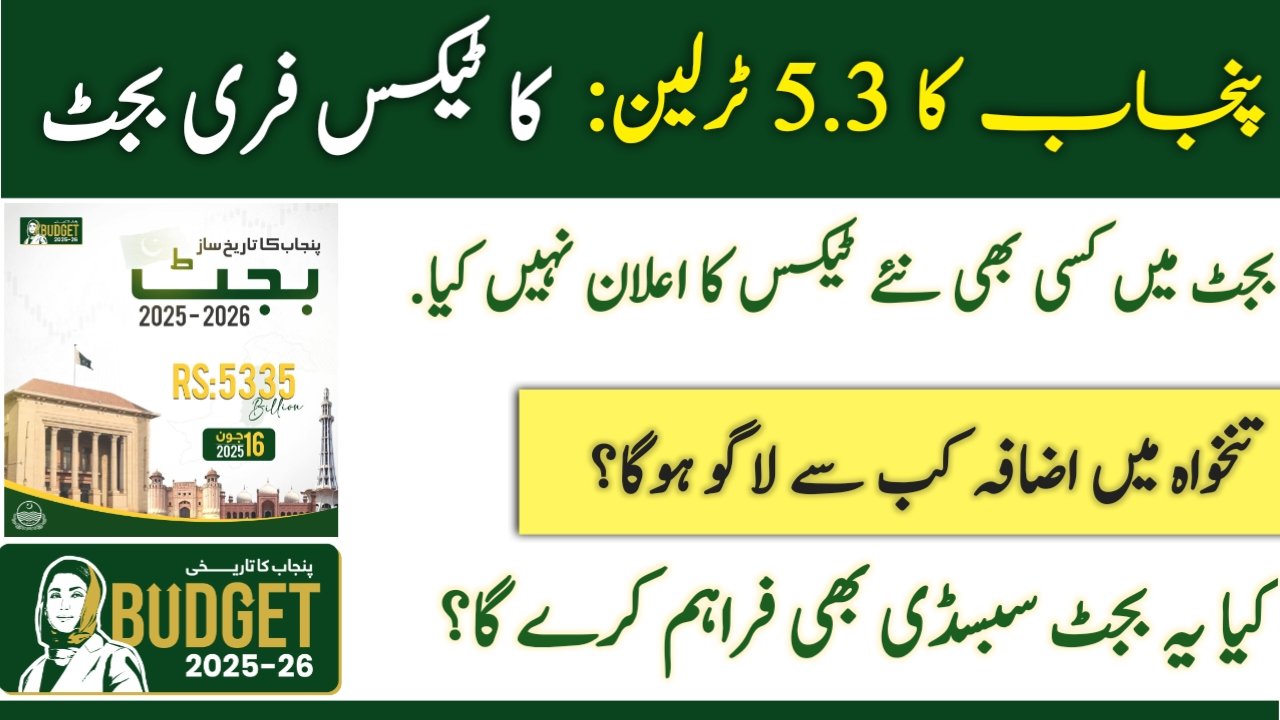Government of Punjab has proposed a new budget for fiscal year 2025-26. This budget contains a total of Rs5,335 billion. It’s considered a zero-tax budget because the government didn’t levy any new taxes or raise tax rates. Mujtaba Shuja ur Rehman, the Finance Minister, presented the budget before the Punjab Assembly. The budget is geared toward assisting businesses, enhancing development projects, and decreasing government spending. It also places a great emphasis on health, education, and local governance. The government wants to help people without putting further financial strain on them.
| Key Area | Highlights |
| Total Budget | Rs5,335 billion |
| Development Programme | Rs1,240 billion |
| New Taxes | None (Zero-tax Budget) |
| Social Protection Package | Rs70 billion |
Punjab Budget 2025-26 Is a Zero-Tax and Pro-Business Budget
Punjab zero-tax budget 2025–26 is intended to benefit both the public and the business community. Finance Minister Mujtaba Shuja ur Rehman affirmed that no new levies were introduced. The administration also did not raise any current tax rates. Senior Minister Marriyum Aurangzeb stated that this budget breaks with tradition and charted a new course for progress. The goal is to stimulate the economy without harming businesses or ordinary citizens. This measure is viewed as a relief to taxpayers and an opportunity for the economy to thrive in a balanced manner.

See also: Punjab Rozgar Scheme
Development Programme Gets 47% More Funds Than Last Year
The development budget of this year was increased to Rs1,240 billion. Last year, it totaled Rs842 billion. This is a 47% increase, which is a significant change. The government intends to use the funds to enhance schools, hospitals, roads, and other public services. The Annual Development Programme (ADP) accounts for 23% of the total budget. The government also stated that its own operational expenses increased by only 3%, despite salary and pension increases. This demonstrates that more money is being directed toward genuine development while less is being spent on government operations.
See also: BISP 8171 Biometric Issue Resolved
Punjab Revenue Targets and Income from NFC Explained
- Punjab’s total income target for 2025-26 is Rs4,890.4 billion.
- Rs4,062.2 billion will come from the federal NFC share (National Finance Commission).
- Rs828.2 billion will come from Punjab’s own resources.
- Punjab Revenue Authority (PRA) has a target of Rs340 billion.
- Board of Revenue will collect Rs135.5 billion.
- Excise Department will collect Rs70 billion.
- Rs470 billion is added as a provincial surplus under an agreement with the IMF.
Health, Education, and Social Sector Are a Top Priority
The Punjab budget 2025-26 places a major emphasis on the social sector. A significant portion of the development funds—Rs494 billion—are set aside for health, education, and social welfare. This sum represents 40% of the entire development expenditure. These sectors have always been crucial to the PML-N government. The purpose is to enhance the lives of ordinary people by providing better hospitals, schools, and assistance. The government also reduced food account spending by 88%, demonstrating improved planning and less waste of public funds.
Local Governments Get Strong Financial Support in Punjab Budget
Local governments receive adequate funding in this year’s Punjab provincial budget. The Provincial Finance Commission (PFC) Award has received Rs764.2 billion.These funds will be utilized by local governments to strengthen city services and governance. The government has also allocated Rs150 billion for garbage management and Rs20 billion to municipal corporations. These funding will help to clean up communities and improve daily services. The goal is to enable local governments to directly serve people while also improving the system’s efficiency.
Social Protection and Welfare Measures for Public Support
Government has introduced a Rs70 billion social protection package. This is in line with the vision of Quaid-i-Azam Muhammad Ali Jinnah to build a welfare state. The goal is to help poor and needy families by giving them financial aid and other support. This package will also help people during tough times, such as job loss or inflation.
Here are the main welfare steps:
- Rs70 billion for social protection
- Rs764.2 billion for local government needs
- Salaries raised by 10%, pensions by 5%
- Reduced food expenses by 88%
These steps show that the government is trying to help the people in real and practical ways.
Conclusion
In this essay, we will go over all of the details of the Punjab budget 2025-26, which is tax-free and growth friendly. The government intends to build the economy and enhance people’s lives by levying no new taxes and increasing public welfare funding. Development, health, education, and local governments have received the top emphasis. The budget also incorporates effective financial planning and reduced excessive spending. The Punjab administration is demonstrating a new approach in which improved planning and people’s welfare go hand in hand.
FAQs
Q1: What does a zero-tax budget mean in Punjab 2025-26?
A zero-tax budget means the government did not add any new taxes or increase any current tax rates in the new budget.
Q2: How much money is given to health and education in this budget?
A total of Rs494 billion has been set aside for the social sector, which includes health, education, and welfare.
Q3: How will local governments use the funds they received?
Local governments will use the funds for waste management, city services, and basic public needs through the Provincial Finance Commission.
Q4: What is the importance of the Rs470 billion provincial surplus?
The Rs470 billion surplus is important because it helps meet targets under the IMF agreement and shows better financial control by the province.

